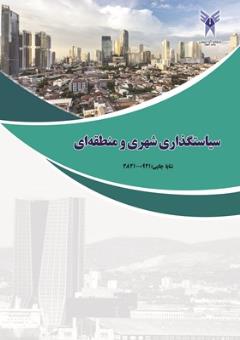تأثیر طراحی و سیاست گذاری شهری بر ارتقای حس تعلق مکانی شهروندان؛ نمونه موردی شهر سنندج
محورهای موضوعی : شهرسازی
بهروز ویسی
1
![]() ,
آسو امامقلی
2
,
آسو امامقلی
2
![]() ,
میدیا صادقی
3
,
میدیا صادقی
3
![]()
1 - دانشجوی کارشناسی ارشد طراحی شهری ، واحد سنندج، دانشگاه آزاد اسلامی، سنندج، ایران
2 - دانشجوی کارشناسی ارشد برنامه ریزی شهری ، واحد سنندج، دانشگاه آزاد اسلامی، سنندج، ایران
3 - دانشجوی کارشناسی مهندسی شهرسازی، واحد سنندج، دانشگاه آزاد اسلامی، سنندج، ایران
کلید واژه: طراحی شهری, حس تعلق به مکان, محله, شهر سنندج,
چکیده مقاله :
حس تعلق به مکان با میزان حضور انسان در محیط پیوند دارد. این حضور صرفنظر از دلیل آن صرفاً یک جنبه کمی برای بیان اعداد و ارقام نیست بلکه جنبه ای کیفی نیز دارد که به دلیل علت های حضور انسان در مکان و فضاهای شهری برمی گردد. در این میان طراحی شهری با ارائه الگوهای مناسب می تواند حس تعلق به مکان را نزد شهروندان ارتقا دهد. در این مقاله سعی شده با مقایسه عوامل مؤثر بر حس تعلق به مکان در چهار محله متفاوت شهر سنندج دلیل رفتارهای سکونتی شهروندان نیز مشخص شود. در این تحقیق با استفاده یک پرسشنامه محقق ساخته به تعداد 331 عدد و به وسیله آزمون همبستگی پیرسون به آزمون سؤالات پرداخته شود. در این تحقیق به این نتیجه دست یافته ایم که عوامل مؤثر بر حس تعلق به مکان نزد شهروندان در محلات مختلف متفاوت از هم هستند برای مثال در محله قدیم و یا میانی عوامل تاریخی و فرهنگی می تواند نقش پر رنگی در ارتقای حس تعلق مکانی داشته باشد اما در محلات جدید شهری فاکتورهای کالبدی مانند فضاهای باز و تفریحی ، امکانات و عناصر طبیعی می تواند نقش مهمی در حس تعلق مکان داشته باشد. در نتیجه افراد در محلات قدیمی و جدید ابعادی از حس تعلق را به دست می آورند و ابعادی را از دست میدهند که در حالت ایده آل به منظور تجمیع حدا کثری عوامل مؤثر بر حس تعلق به مکان در یک محله، گام نخست شناسایی و قیاس عوامل بود که در این مقاله بدان پرداخته شد.
The sense of belonging to a place is related to the amount of human presence in the environment. Regardless of the reason, this presence is not just a quantitative aspect to express numbers and figures, but also has a qualitative aspect that is due to the reasons for human presence in urban spaces and places. In the meantime, urban design can promote the sense of belonging to a place among citizens by providing suitable patterns. In this article, by comparing the factors affecting the sense of belonging to the place in four different neighborhoods of Sanandaj city, it is tried to determine the reason for the residential behavior of the citizens. In this research, using a researcher-made questionnaire with 331 numbers and using the Pearson correlation test, the questions will be tested. In this research, we have come to the conclusion that the factors affecting the sense of belonging to the place among citizens are different in different neighborhoods, for example, in the old or middle neighborhood, historical and cultural factors can play a colorful role in promoting the sense of belonging to a place. But in new urban areas, physical factors such as open and recreational spaces, facilities and natural elements can play an important role in the sense of place. As a result, people in old and new neighborhoods gain dimensions of sense of belonging and lose dimensions that ideally, in order to gather as many factors as possible on the sense of belonging to a place in a neighborhood, the first step is to identify and compare the factors. It was discussed in this article.


